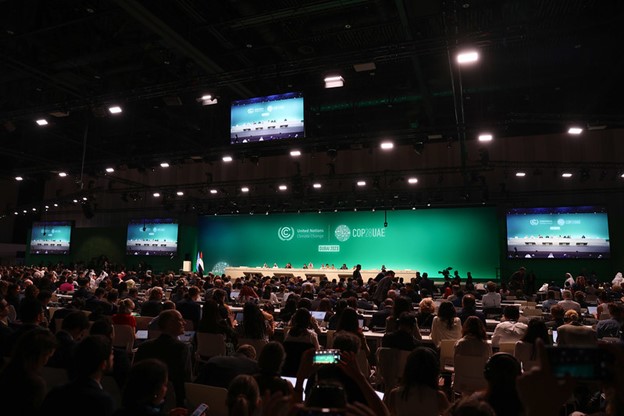Evaluating COP28: Adaptation Agenda Neglected; Mitigation Pledges Insufficient
By Humzah Khan, FTDES Volunteer
This past December, policymakers, business leaders, climate experts, and environmental activists gathered in Dubai for the 28th United Nations Conference of the Parties (COP28). Under the UN system, COPs are the annual meetings of signatories to the United Nations Framework Convention on Climate Change (UNFCCC). It is the most significant global convening focused on climate change. An estimated 65,000 participants attended the summit, making COP28 by far the largest COP meeting.
The official outcome of the summit is known as the UAE Consensus [1], finalized and approved by negotiators from almost 200 countries. The UAE Consensus delivers several noteworthy breakthroughs on climate change mitigation, such as an explicit call for “transitioning away from fossil fuels.” Other important mitigation commitments seek to slash methane emissions, expand renewable energy capacity, and accelerate energy efficiency improvements. COP28 also scored an early win with the launch of a “loss and damage fund,” which was seeded with a modest $661 million in pledges [2]. The World Bank was designated interim host of the fund, despite concerns from indebted developed countries distrustful of the Bank’s lending practices [3]. The actual impact of the fund is contingent on the outcome of a complicated arrangement between UNFCC and the World Bank [4]. Unfortunately, COP28 failed to deliver actionable commitments on the climate change adaptation agenda. The final text’s global adaptation targets are vague and decoupled from adaptation financing targets.
Mitigation and Adaptation
According to the Intergovernmental Panel on Climate Change (IPCC), the lead global climate science agency, the world’s average surface temperature rise must be limited to 1.5 degrees Celsius above pre-industrial levels to avoid catastrophic consequences to global ecosystems [5]. This is only possible through immediate and major cuts in greenhouse gas emissions. Greenhouse gas emissions drive climate change by trapping heat below the atmosphere. Climate change mitigation is the reduction of the flow of greenhouse gas into the atmosphere. The most efficient and effective way to mitigate climate change is to reduce greenhouse gas emissions, mainly by replacing fossil fuels with alternative energy sources (renewelable energy). Mitigation can also be achieved by removing greenhouse gases from the atmosphere. However, emission removal strategy relies on new technologies that are unproven at scale, namely Carbon Capture and Storage (CCS) [6]. Policymakers have become more interested in CCS in recent years, and an estimated 475 lobbyists working on CCS attended COP28 [7]. Environmental activists worry promoting unproven mitigation strategies only serves to postpone the energy transition by allowing for continued use of fossil fuels. The UAE Consensus reflects a push by petrostates to include loopholes promoting CCS technologies as well as “transitional fuels” such as natural gas [8].
But the effects of climate change are already being felt around the world. 2023 was the hottest year on record, with a marked increase in climate change-related events such as heatwaves, wildfires, floods, and storms [9]. The IPCC estimates that about 3.6 billion people—more than a third of the global population—live in contexts vulnerable to climate change [10]. It is therefore not enough just to mitigate climate change. Populations around the world must also adapt to a changing climate. Climate change adaptation can take a variety of forms depending on local contexts and capabilities. Accelerated resilience efforts are especially needed to protect fragile ecosystems such as islands, oases, forests, and rangelands from irreversible damage [11]. Coastal communities must invest in infrastructure to combat sea level rise and increasingly destructive storms. Agriculture value chains need to account for increasing water scarcity. Healthcare systems must build capacities to respond to increasingly frequent extreme weather events, such as heatwaves and wildfires. These efforts require political will, capital investments, and broad buy-in. As the effects of climate change intensify, adaptation needs will become increasingly urgent.
International Coordination on Climate Change Adaptation
Climate change adaptation is grossly underfunded. A major UN Environment Programme report estimates developing countries need between $215 billion and $387 billion annually to meet adaptation costs [12]. However, international finance flows to support adaptation in developing countries totaled $21.3 billion in 2021— a 15 percent decrease in funding from $25.2 billion in 2020. The report notes that financing for mitigation increased over the same period. What makes financing for adaptation difficult to secure?
Many of the challenges in advancing adaptation stem from the highly localized nature of adaptation solutions. The objective of mitigation is relatively straightforward: cut or remove emissions. Adaptation requires a dynamic understanding of how climate change will impact specific populations, ecosystems, and economies. For example, adaptation for one seaside town threatened by sea-level rise may require a higher seawall, whereas adaptation for another seaside town may require relocation inland. The diversity of adaptation circumstances and solutions complicates efforts to agree on common international metrics to measure adaptation progress [13]. Furthermore, private investors are often uninterested in funding adaptation projects because of a perceived lack of profitability [14]. According to an estimate by the Organization for Economic Cooperation and Development (OECD), just about 5 percent of private capital mobilized for climate action between 2016 and 2020 was allocated for adaptation projects [15]. Populations vulnerable to climate change often live in developing countries already burdened by debt. Of the 30 countries most vulnerable to climate change, not one is among the top 30 recipients of climate financing [16]. For these reasons, international discussions on adaptation tend to center around financing, and particularly the role of developed countries in financing adaptation in the developing world.
Negotiating Adaptation
Negotiations at COPs offer some insight into the difficulties of financing adaptation. As part of the Paris Agreement adopted at COP21 in 2015, countries agreed to coordinate adaptation efforts by establishing a Global Goal for Adaptation (GGA). Little was done to substantively define or implement the GGA in the following years [17], although many countries released national adaptation planning strategies [18]. Ahead of COP28, countries agreed to finalize a framework for the GGA. Although delegates acknowledged that quantifying adaptations goals would be difficult, negotiators hoped to advance the GGA as a “North Star” to guide country-level efforts [19]. But contentious debate over the GGA at COP28 revealed fault lines between developed and developing countries, as well as the challenges of global cooperation.
The main disagreement between developed and developing countries centered around the inclusion of financing targets. Developed countries wanted to focus on adaptation policy goals, but developing countries argued that adaptation goals need to be paired with financing targets for developing countries. Developed countries, reportedly led by the United States, successfully struck references to finance targets and calls for contributions from developed countries in the final text [20].
A more dramatic disagreement emerged around the UNFCC principle of “common but differentiated responsibilities and respective capabilities (CBDR-RC),” which assigns historical responsibility to developed countries for climate action because of their greater contributions to climate change [21]. The CBDR-RC principle was formalized as part of mitigation agreements in 1992. Developing countries wanted to enshrine a similar equity principle as part of adaptation agreements, whereas developed countries resisted it. Most developing countries were willing to negotiate, but a group of more advanced developing countries refused to engage and insisted on CBDR-RC’s inclusion [22]. This group consisted of an Arab bloc led by Saudi Arabia and countries from the Like-Minded Developing Countries bloc (which includes many OPEC countries), led by China. Reportedly, the group fixated on CBDR-RC as a way of holding the adaptation talks hostage in exchange for concessions in other COP negotiations on mitigation [23]. As a result, adaptation negotiations were deadlocked for nine days, threatening any progress on the GGA [24]. The stalemate illustrates the ability of a minority of countries to scuttle progress at the UN.
The final GGA language lacks a commitment to closing the adaptation finance gap and makes no reference to differentiated responsibility for developed and developing countries [25].
Conclusion
COP28 restores limited hope in the UN system. It is clear countries acknowledge the existential threat posed by climate change. However, the UAE Consensus falls well short of the action needed to prevent climate catastrophe. The International Energy Agency (IEA) estimates that if all COP28 mitigation pledges are fulfilled by 2030, the emissions reduction would be just 30 percent of the reduction needed to be on track to limiting global warming to 1.5 degrees Celsius [26]. Neglect of the adaptation agenda will lead to increased suffering as the effects of climate change continue to intensify. The international community must make credible commitments to transition away from fossil fuels and meaningfully elevate the adaptation agenda.
[1] https://unfccc.int/sites/default/files/resource/cma2023_L17_adv.pdf
[4]https://odi.org/en/insights/will-the-world-bank-make-good-on-the-loss-and-damage-fund/
[5] https://www.ipcc.ch/report/ar6/syr/downloads/report/IPCC_AR6_SYR_SPM.pdf
[6]https://eenews.net/articles/u-n-slams-carbon-removal-as-unproven-and-risky/
[8]https://www.reuters.com/business/environment/what-are-loopholes-cop28-climate-deal-2023-12-14/
[9]https://www.nytimes.com/2024/01/09/climate/2023-warmest-year-record.html
[10]https://www.ipcc.ch/report/ar6/wg2/chapter/summary-for-policymakers/
[12]https://www.unep.org/resources/adaptation-gap-report-2023
[14]https://www.weforum.org/publications/accelerating-business-action-on-climate-change-adaptation/
[16] https://www.ifrc.org/document/making-it-count-smart-climate-financing-most-vulnerable-people
[17]https://www.wri.org/insights/global-goal-on-adaptation-explained
[20]https://www.carbonbrief.org/cop28-key-outcomes-agreed-at-the-un-climate-talks-in-dubai/
[23]https://www.carbonbrief.org/cop28-key-outcomes-agreed-at-the-un-climate-talks-in-dubai/
[25]https://unfccc.int/sites/default/files/resource/cma2023_L17_adv.pdf
[26]https://www.iea.org/news/iea-assessment-of-the-evolving-pledges-at-cop28

 Français
Français العربية
العربية





